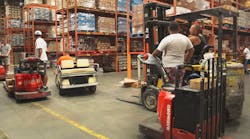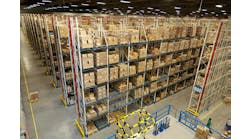After a period of economic downturn, many companies are beginning to recover and experience business growth again. While some warehousing organizations believe the next logical step in growth is to expand and establish new sites, others are realizing that less is actually more by consolidating and centralizing operations.
Typically, large corporations have a main on-site warehouse, accompanied by multiple external locations. Managing geographically dispersed satellite warehouses requires labor-intensive efforts that can compromise productivity, especially when the organization is handling a high volume of orders that require picking products stored in disparate warehouses. This becomes a logistics nightmare, as workers are trying to aggregate these scattered items in order to send them to a single destination.
By consolidating operations from several smaller, remote locations into one large, centralized warehouse, organizations can reduce the volume of work needed in external sites, such as order picking, and eliminate the logistical challenge of collecting products residing in multiple locations.
Successful consolidation can be achieved with automation technology, specifically high-density automated storage and retrieval systems (AS/RS). The following are three chief areas in which automation enables effective warehouse consolidation and centralization.
-
Cube Utilization: High-density AS/RS allows for improved cube utilization, or storing products more effectively in the existing facility rather than expanding the storage space of the warehouse itself. This ensures not only that the existing facility can accommodate the combined inventory, but also minimize the facility’s real estate footprint and decrease energy usage. Oftentimes, improved cube utilization can eliminate or reduce the need for new construction (for example, building a new, larger facility). New construction may be an expensive option with little return on investment.
-
Control: Automating processes within a centralized location gives warehouse personnel greater control over operations. The software component of an AS/RS helps users boost inventory accuracy – workers know where and how much product is located within the facility and can keep inventory levels to a minimum. Additionally, there is no need to search for products across several small, disparate warehouses and then consolidate in a struggle to fill orders in a timely manner.
-
Cost Savings: Automation of an existing facility may provide a return on investment not found in new construction. The efficiencies provided by AS/RS can lead to fewer errors, less damage and a faster turnaround for order fulfillment due to less-complicated logistics. Reducing labor and energy costs provides even more savings.
It is important to note that automation is not about bringing dispersed warehouse operations and old processes together in one place. Automation can revamp and improve processes so that large volumes of orders are handled with greater efficiency.
Gary Frank is vice president of automated systems for Westfalia Technologies.




